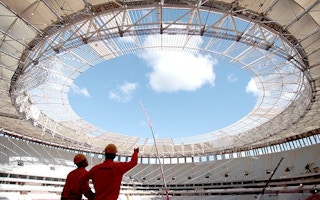Eleven of the 32 countries competing in the forthcoming football World Cup are unable to generate as much solar energy as Brazil’s 2.5MW national stadium.
So claims the ‘Poor Peoples’ Energy Outlook’ (PPEO) report published today by British NGO Practical Action.
The newly constructed national stadium and World Cup venue, Estádio Nacional Mané Garrincha in Brasilia, produces 2.5MW of solar energy.
But the report highlights the competing countries of Bosnia-Herzegovina, Croatia, Cameroon, Colombia, Costa Rica, Ecuador, Honduras, Iran, Ivory Coast, Uruguay and Ghana all produce the same or less than 2.5MW of solar power, the report said.
Brazil will generate more renewable energy than any other world cup before it. It is also sponsored by global solar company, manufacturer Yingli Green.
It is “vital that we follow the example set by the World Cup organisers and invest heavily in the new technology we are seeing used so well in Brazil”, said Simon Trace, CEO of NGO Practical Action.
“
Between the 2.5MW solar power from the Estádio Nacional Mané Garrincha in Brasilia, the 1.4MW from Mineirão in Belo Horizonte, the 1MW Itaipava Arena in Pernambuco, and the 500KW array for the iconic venue for the World Cup Final, Estádio do Maracanã, Brazil’s World Cup stadia will produce 5.4 MW of solar
“On one hand, the organisers and FIFA are to be congratulated for making a considerable financial investment and making this the greenest World Cup in history,” said Trace.
But according to the World Bank, there are still 1.2 billion people – a fifth of the world’s population – without electricity. Almost double this figure relies on hazardously burning manure, wood or coal. “It is absurd that there has been a greater investment into renewable energy for a single sporting event than in 11 of the countries competing in it,” said Trace.
Without access to energy, Trace said, “there will always be a substantial proportion of the world’s population living in poverty”.
Trace says “most of these are developing countries, in which economic growth, health and education of millions of people is severely restricted by the lack of access to electricity for the majority of the population.”
The PPEO 2014 report will be launched at the United Nations Sustainable Energy for All Forum in New York.
The PPEO report aims to show what strategies are needed to end energy poverty, with access for all, stressing “business as usual” will not work to end energy poverty by 2030.
PPEO predicts with business as usual – there will still be one in five people with no electricity, and a stagnant third of the global population without modern energy services.
Launched in 2011, the goal of the UN Secretary General’s Sustainable Energy for All initiative is for universal access to energy for everyone.
The report found the only way of reaching the fifth of global populations without electricity is “not via traditional grid-based electrification as found in the west, but via smaller scale, renewable off-grid solutions such as solar, hydro and wind”.
Between the 2.5MW solar power from the Estádio Nacional Mané Garrincha in Brasilia, the 1.4MW from Mineirão in Belo Horizonte, the 1MW Itaipava Arena in Pernambuco, and the 500KW array for the iconic venue for the World Cup Final, Estádio do Maracanã, Brazil’s World Cup stadia will produce 5.4 MW of solar power.










